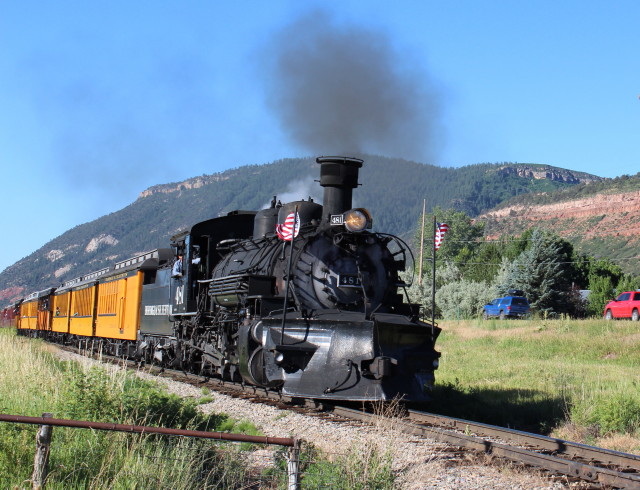Durango
Durango began as a railroad
town with a mining and smelting center during the gold and
silver booms. It is now a crossroads for local industry,
ranching, commerce and culture. Vestiges of the past accent
Durango's Victorian downtown, where visitors can still enjoy the
spirit of that colorful era.
Durango is a natural
gateway to the San Juan Mountains, one of the more scenic
sections of the state. Because they are geologically younger
than the other Colorado mountain ranges, the San Juan present a
more jagged, precipitous appearance.
After arriving in town and
finding the train station, we then drove out of town (US 550)
going parallel to the rail line. About a mile out of town we
turned down a side street for our first runby and photo shot.
US 550 runs north from Durango
to Silverton and Ouray: the part of the road that is known as
the Million Dollar Highway includes many overlooks and is cut
from nearly vertical cliff sides. Because the road has steep
drop-offs and no guardrails it should be traveled with caution.
Animas River, River of Lost Souls, the railroad
follows the river to Silverton.


After the train passed by
we jumped into the car and drove a couple of miles to get
ahead of the train and our next photo spot.

Then it was a quick exit
jumping in the car and driving to the next spot.

The old wooden water tank in Hermosa, one of only two remaining
on the Durango Silverton line, has been structurally stabilized
but it not operational at this time. Water is currently drained
out of a converted tank car when needed. The D&RG built this
wooden water tank at Hermosa so engine crews could fill their
tenders one last time before heading up the long hill here to
Rockwood.

Fire patrol on duty looking for embers.

Our last photo stop.

This is the end of our chasing the Durango & Silverton
Railroad. We have been continuing on US 550 to chase the train.
We will continue on US 550 north.

Silverton in the distance with the Animas River.

For Sale

Ouray.
The town draws its name
from the Ute chieftain Ouray (you-RAY). Before the miners
arrived, the Native Americans came to the area to enjoy the
hot springs. The first silver strike was made in1875. The
politics, foibles and personalities of the mining camps were
lambasted in the Solid Muldoon; the paper became one of
the most widely quoted of the time-even Queen Victoria of
England was a subscriber.

Not silver but gold
stabilized the community after the Panic of 1893. The wealth
that poured from Tom Walsh's Camp Bird Mine amounted to
$24million 1896-1902. The fortune bought the family a place in
Washington, D.C., society and daughter Evelyn the Hope
Diamond. Mining has long since given way to year-round tourism
as the leading factor in Ouary's economy.

Ridgway is at the junction of US 550 and Rt 62 and is nestled
between the verdant San Juan and Uncompahgre national forests
with the rugged San Juan Mountains serving as a dramatic
backdrop.

From our stop in Ridgway we
proceeded north on US 550 to Montrose, junction of the US 550
and US 50. Turning right on US 50 we headed east. Western
parts of US 50 are known as the loneliest road in America. It
continues east and runs past my aunt's home in Annapolis and
on the Bay Bridge over the Chesapeake Bay to the Eastern Shore
of Maryland.

Museum of the Mountain West is outside Montrose. It looked like
an interesting place but we didn't have time to visit on this
trip.

Our first stop on US 50 was in Cimarron for a display of rail
cars.

Cimarron Visitor Center, 20 miles east of Montrose just off US
50, has a narrow-gauge railroad engines, coal tender, freight
car and caboose displayed.

Cattle pens for loading into rail cars.

278 DRGW C-16 2-6-0.

Authors Robin and Chris.

An interesting item in the collection.

We had a nice drive along Blue Mesa Reservoir to our next stop
in Gunnison.
Gunnison
In the broad, fertile
valley of the Gunnison River, Gunnison was settled in 1874;
the town was founded in 1880 as a mining supply camp.
Operating as a trade center for the area's ranching operations
as well as home to Western State College, Gunnison serves as a
gateway to the Gunnison National Forests and Curecanti
National Recreation Area.
Gunnison Pioneer Museum.
Gunnison Pioneer Museum
occupies 26 buildings, including two restored schoolhouses
and an 1876 post office. A car barn holds more than 80
antique vehicles; another building houses antique ranch
wagons and buggies, a milk wagon, a horse-drawn hearse, a
taxi and an antique oxcart.Another building is devoted to
military history. Displays of cowboy paraphernalia;
antique print shop, carpenter shop and blacksmith shop
artifacts.
A narrow-gauge railroad engine and 1881
rail cars are on the grounds.
